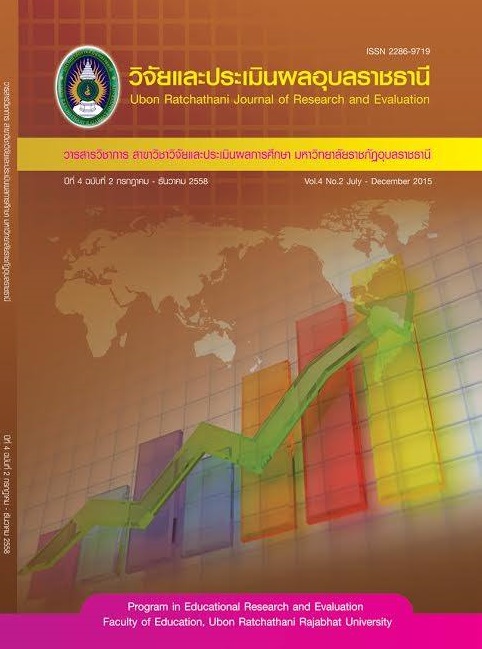A Development of Reasonable Thinking Skills Using PICA Model in a Thai Subject for Prathom Suksa 1 Students under Ubon Ratchathani Primary Educational Service Area Office 3
Keywords:
PICA Model of Teaching, Reasonable ThinkingAbstract
The purposes of this study were to (1) investigate the development of reasonable thinking skills, (2) compare the effect of the students’ reasonable thinking skills in the experimental group with the set criteria, and (3) compare the effect of the development of reasonable thinking skills of the experimental group using PICA model in a Thai subject with that of the control group using a regular teaching model for Prathom Suksa 1 students under Ubon Ratchathani Primary Educational Service Area Office 3. The samples of the study in the experimental group were 17 Prathom Suksa 1 students studying at Ban Nangsaeng-Wang Ang School selected by a purposive sampling. The research instruments included 12 lesson plans using PICA model, the end-of-cycle test, a form assessing reasonable thinking skills. The basic statistical procedures were used for analyzing the quantitative data while Mann Witney-U test was used for range order.
The research findings were as follows:
- The students were able to do activities by themselves, independent to think in various ways, and develop thinking skills in word identification, be able to compare and classify groups of words according to the set criteria. In terms of series, the students were able to arrange orders of words and situations. In terms of making conclusion, the students could make a conclusion from the given situation and story, enabling the students to develop reasonable thinking skills higher.
- The students were able to think reasonably higher than the set criteria with statistical significance at the critical level .05.
- The students in the experimental group that used the PICA Model had reasonable thinking skills higher than the control group which used the regular teaching method with statistical significance at the critical level .05.
References
สาขาวิจัยและประเมินผลการศึกษา. อุบลราชธานี: คณะครุศาสตร์มหาวิทยาลัยราชภัฏอุบลราชธานี, 2553.
กัญญารัตน์ แสวงสุข. การพัฒนาทักษะการคิดพื้นฐานในกลุ่มสาระการเรียนรู้วิทยาศาสตร์สำหรับนักเรียนชั้นประถมศึกษาปีที่ 4 โรงเรียนบ้านกระทุ่มอำเภอจอมพระจังหวัดสุรินทร์. วิทยานิพนธ์ศึกษาศาสตรมหาบัณฑิต มหาวิทยาลัยขอนแก่น, 2547.
กุลยา ตันติผลาชีวะ. “การคิด,” วารสารการศึกษาปฐมวัย. 3 (กรกฎาคม 2548): 41-45.
คณะกรรมการการศึกษาขั้นพื้นฐาน, สำนักงาน. แนวทางการการเรียนรู้สู่ประชาคมอาเซียนระดับประถมศึกษา. กรุงเทพฯ: ชุมนุมสหกรณ์การเกษตรแห่งประเทศไทย จำกัด, 2554.
. ข้อมูลการศึกษาแห่งชาติ ปีการศึกษา 2539-2541. กรุงเทพฯ: สำนักงานคณะกรรมการการศึกษาแห่งชาติ, 2542.
จำนง วิบูลย์ศรี. อิทธิพลของภาษาต่อการคิดเชิงเหตุผลในเด็กไทย. พิมพ์ครั้งที่ 2. กรุงเทพฯ: โรงพิมพ์จุฬาลงกรณ์มหาวิทยาลัย, 2536.
ธีรวุฒิ เอกะกุล. การวิจัยปฏิบัติการ. พิมพ์ครั้งที่ 3. อุบลราชธานี: ยงสวัสดิ์อินเตอร์กรุ๊ป, 2553.
รัศมี เรือนเจริญ. การพัฒนาทักษะการคิดอย่างมีเหตุผลโดยใช้การจัดการเรียนรู้แบบ PICA วิชาภาษาไทย สำหรับนักเรียนชั้นประถมศึกษาปีที่ 1 สังกัดสำนักงานเขตพื้นที่การศึกษาประถมศึกษาอุบลราชธานีเขต 3. วิทยานิพนธ์ครุศาสตรมหาบัณฑิต มหาวิทยาลัยราชภัฏอุบลราชธานี, 2558.
วิชาการและมาตรฐานการศึกษา, สำนัก. ทักษะการคิด. กรุงเทพฯ: สำนักงานคณะกรรมการการศึกษาขั้นพื้นฐาน, 2549.
สุธาทิพย์ งามนิล และคนอื่น ๆ รูปแบบการจัดการเรียนรู้เพื่อพัฒนาทักษะการคิดของนักเรียนช่วงชั้นที่ 1
(ป.1-ป.3). นครสวรรค์: คณะครุศาสตร์มหาวิทยาลัยราชภัฏนครสวรรค์, 2552.
เอ็ดเวิร์ด เดอ โบโน. สอนศิษย์ให้คิดเก่ง แปลจาก Teaching Thinking. โดย ทวี ลักษมีวัฒนา และกานต์สุดา มาฆศิรานนท์. กรุงเทพฯ: บริษัท เอ็กซเปอร์เน็ท จำกัด, 2550.
เอมอร กฤษณะรังสรรค์. รูปแบบการคิด Cognitive Style และรูปแบบการเรียนรู้ Learning Style (ออนไลน์)ม.ป.ป. (อ้างเมื่อ15 ตุลาคม 2555). จาก: www.bs2504.thport.com/Vinaip/articles/01Csls.htm.
Downloads
Published
How to Cite
Issue
Section
License
1. บทความที่ตีพิมพ์ในวารสารนี้ได้มีการตรวจสอบการลอกเลียนงานวรรณกรรมแล้ว ไม่เกินร้อยละ 25
2. บทความที่ตีพิมพ์ในวารสารนี้เป็นข้อคิดเห็น ข้อค้นพบของผู้เขียนบทความ โดยผู้เขียนบทความต้องเป็นผู้รับผิดชอบต่อผลทางกฎหมายใด ๆ ที่อาจเกิดขึ้นจากบทความนั้น ๆ
3. บทความ ข้อมูล เนื้อหา รูปภาพ ฯลฯ ที่ได้รับการตีพิมพ์ในวารสารวิจัยและประเมินผลอุบลราชธานี ถือเป็นลิขสิทธิ์ของวารสารวิจัยและประเมินผลอุบลราชธานี หากบุคคลหรือหน่วยงานใดต้องการนำทั้งหมดไปเผยแพร่ต่อหรือเพื่อกระทำการใดๆ จะต้องได้รับอนุญาตเป็นลายลักษณ์อักษรจากวารสารวิจัยและประเมินผลอุบลราชธานีก่อนเท่านั้น และจะต้องมีการอ้างอิงวารสารวิจัยและประเมินผลอุบลราชธานี ฉบับนั้น ๆ ด้วย






